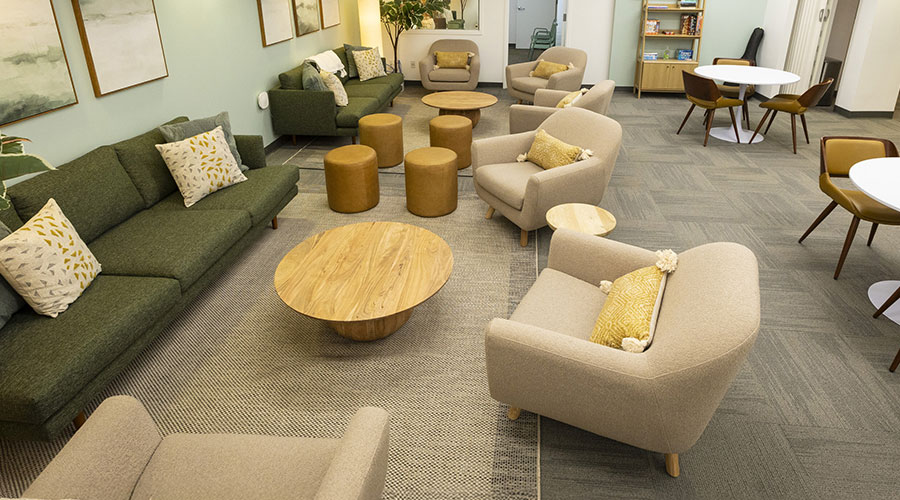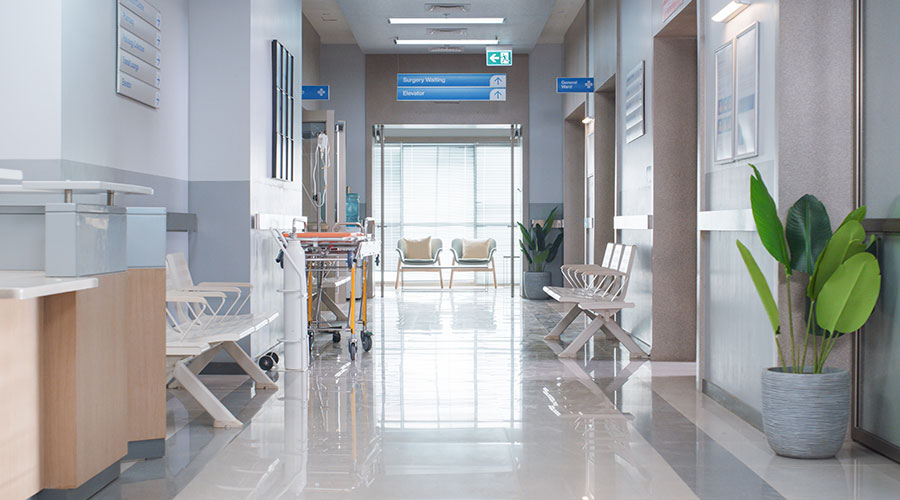In mass media, hospitals and other healthcare facilities are typically depicted as stale, cold environments. All-white design choices symbolize that people are in sterile environments with no possibility of being sick. But that isn’t always the case. Even in a healthcare setting, people can still get sick. Knowing this, designers are forced to be even more creative and think outside the box by using information relayed by patients, staff and visitors. There doesn’t have to be a compromise when designing a space that can be welcoming while also safe.
Healthcare Facilities Today recently spoke with Cheryl Lauren Spigler, director, senior design leader of NELSON Worldwide on how designers can strive to design aesthetically pleasing healthcare spaces while also preventing HAIs.
HFT: How do you design spaces to be adaptable for future changes in infection control practices or emerging health threats?
Cheryl Lauren Spigler: Working with end-users and stakeholders to fully understand their current and future goals is essential to designing spaces that can be adaptable for future changes in infection control practices or emerging health threats. This involves incorporating flexibility, foresight, and modularity into your design approach.
1: Modular Design
- Flexible Layouts: Use modular furniture and partitions that can be easily rearranged or replaced as needs change. Modular systems allow for quick reconfiguration of spaces to accommodate different functions or increased space requirements.
- Interchangeable Components: Design with interchangeable components for key elements like wall panels, flooring, and lighting fixtures. This makes it easier to update or replace components without major overhauls.
2: Future-Proof Materials
- Durable and Adaptable Materials: Select materials that are not only durable but also adaptable to new cleaning protocols. Choose finishes and surfaces that can withstand changes in cleaning agents or techniques.
- Antimicrobial and Self-Cleaning Surfaces: Consider incorporating materials with built-in antimicrobial properties or self-cleaning surfaces that can help reduce the spread of pathogens and adapt to new hygiene standards.
3: Design for Easy Updates
- Concealed Systems: Design utility systems (such as electrical wiring, HVAC, and plumbing) to be easily accessible for maintenance and upgrades. Conceal systems in accessible panels or service corridors to simplify future modifications.
- Interchangeable Fixtures: Use fixtures that can be easily updated or replaced. For example, lighting systems and hand sanitizing stations should be designed for easy replacement or upgrading as new technologies emerge.
- Wall Panels with Easy Access: Design walls with access panels or removable sections for easy installation of new technology or modifications to existing systems. By incorporating these strategies, you can create spaces that are not only resilient and adaptable but also prepared to evolve with future needs and emerging health threats.
4: Adaptable Infrastructure
- Flexible Spaces: Incorporate spaces that can be easily adapted for different uses, such as convertible waiting areas that can be reconfigured into isolation zones if needed.
- Infrastructure for Future Technologies: Plan for the integration of future technologies, such as advanced air filtration systems, touchless interfaces, or advanced monitoring systems. Ensure that infrastructure like conduits and space for additional equipment is built into the design.
- Designing to highest acuity: Rooms that can flex from standard overnight to ICU allows less movement of patients from room to room and affords the flexibility for the facility to use the room as needed during surges.
- Adaptable infrastructure: Designing rooms that can be switched to negative pressure so a room can serve as airborne isolation and flex as needed.
Related: What Materials Can Prevent HAIs?
HFT: What special considerations are there for designing quarantine areas in hospitals?
Spigler: Designing quarantine areas in hospitals requires a careful balance of functionality, safety, and patient comfort. Here are some special considerations to ensure these areas remain effective and efficient:
1: Containing the spread
- Isolation and Containment: This should be flexible and easily implemented and modified by hospital staff so areas can be created as needed for quarantine and airborne isolation rooms.
- Airflow Management: Ensure quarantine areas have separate HVAC systems or dedicated air handling units to prevent cross-contamination. Use high-efficiency particulate air (HEPA) filters and maintain negative pressure relative to adjacent areas to contain airborne pathogens.
- Controlled Negative Pressure: Negative pressure that can be switched on or off as needed to create isolation rooms as needed provides flexible use of spaces.
- Sealed Barriers: Design with physical barriers such as sealed doors, windows, and walls to prevent the spread of contaminants. Use materials that are easily cleanable and resistant to chemicals.
- Controlled Access: Implement strict access controls with secure entry and exit points that can be switched on or off. Use electronic or manual systems to ensure only authorized personnel can enter.
2: Infection Control
- Material Selection: Choose non-porous, antimicrobial materials for surfaces and finishes. Materials should be resistant to stains, easy to clean, and durable under frequent disinfection.
- Hand Hygiene Stations: Place hand hygiene stations (sanitizer dispensers, sinks) at the entrance and exit of the quarantine area for easy access.
- Waste Disposal: Design dedicated waste disposal areas with appropriate containment for hazardous or infectious waste. Ensure easy access for waste removal and disposal.
3: Patient Comfort and Safety
- Privacy and Dignity: Provide adequate privacy for patients, including visual and auditory privacy. Use partitions or enclosed rooms where possible to ensure a sense of security and dignity.
- Comfort Features: Include comfortable, easy-to-clean furnishings. Ensure that the environment is as calm and supportive as possible, considering factors like lighting and noise reduction.
- Communication Systems: Install communication systems that allow patients to contact medical staff easily. Consider video or intercom systems for communication between patients and caregivers.
4: Staff Workflow and Protection
- Designated Zones: Create separate zones for staff, including clean and contaminated areas. Ensure there is a clear transition area where staff can change into and out of protective gear.
- PPE Stations: Provide stations with personal protective equipment (PPE) such as gowns, gloves, masks, and face shields. Include instructions for proper donning and doffing procedures.
- Training and Protocols: Design the space to facilitate training on infection control and emergency protocols.
- Surveillance Systems: Install surveillance systems for monitoring activity within the quarantine area. Ensure that cameras are strategically placed to ensure safety and compliance without compromising patient privacy.
- Environmental Monitoring: Incorporate systems to monitor air quality, temperature, and humidity. Ensure that these systems are regularly maintained and checked.
5: Flexibility and Adaptability
- Modular Design: Use modular design principles to allow for flexibility in the layout of quarantine areas. This can accommodate varying patient numbers and different types of infectious diseases.
- Futureproofing: Consider potential future needs, such as the integration of new technologies for infection control or changes in healthcare protocols. Ensure that the design can accommodate such updates.
6: Compliance and Regulations
- Regulatory Standards: Ensure the design complies with local, national, and international health and safety regulations and standards. This includes standards set by organizations such as the Centers for Disease Control and Prevention (CDC), World Health Organization (WHO), and other relevant bodies.
By addressing these considerations, you can design quarantine areas that are not only effective in controlling infection but also supportive of both patient needs and staff workflows.
Mackenna Moralez is the associate editor of the facilities market.

 Designing Healthcare Facilities for Pediatric and Geriatric Populations
Designing Healthcare Facilities for Pediatric and Geriatric Populations Kaiser Permanente Announces New Hospital Tower at Sunnyside Medical Center
Kaiser Permanente Announces New Hospital Tower at Sunnyside Medical Center Building Disaster Resilience Through Collaboration
Building Disaster Resilience Through Collaboration Amae Health Expands to New York City
Amae Health Expands to New York City Hospital for Special Surgery Opens Two New Facilities in New Jersey
Hospital for Special Surgery Opens Two New Facilities in New Jersey